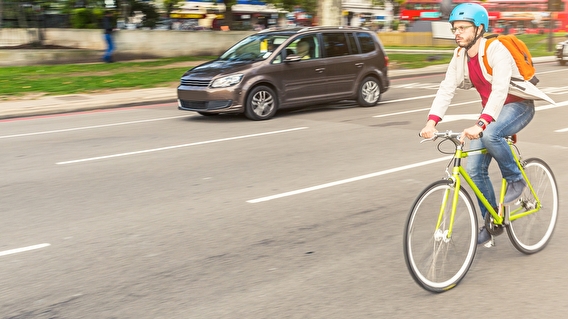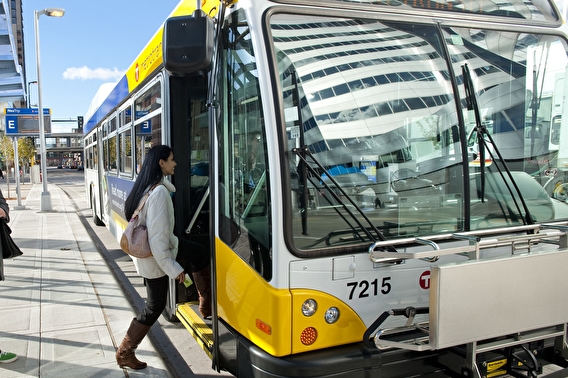
It’s no secret that the transportation system is an uneven playing field. Understanding disparities related to race, income, and other factors is critical, and much more work is needed. Gender in particular is an under-researched yet important aspect of the design of vehicles, infrastructure, and amenities.
To explore this issue, the Minnesota Chapter of the Transportation Research Forum hosted a virtual seminar in August. Established in 2018, the chapter is co-led by Frank Douma, a researcher with the U’s Humphrey School of Public Affairs, and Deborah Carter McCoy, director of strategic communications at the Environmental Initiative.
Seminar presenters focused on the ties between gender and personal safety in transportation—offering insight for designing a transportation system that is safe for all.
Bicycling is one area in which the disparities between men and women are clear: Women are far less likely to bicycle than men, and safety concerns are a major reason why. At the seminar, Hennepin County transportation planner Jordan Kocak described a recent bicycle passing project completed with Humphrey School of Public Affairs professor Greg Lindsey that revealed unforeseen gender-related results.
“We were exploring the factors that affected vehicle passing distance and encroachment on bicyclists using radar devices on a variety of roadways,” he said. “Unexpectedly, we found that our female rider had nearly three times as many encroachments as our male riders, and the average passing distance for our female rider was three inches closer.”
Kocak says this research, as well as other studies that show female riders prioritize safety and may have a lower risk tolerance, are informing the county’s bicycle facility planning and its effort to raise the percentage of female bike commuters. The county is currently modifying many roadways to separate bicycle facilities from traffic and connecting existing separated bike facilities. “If you have more women biking, you know you have created bike facilities that are better for a wider variety of people by allowing bicyclists to feel safe and comfortable,” he added.
University of Arizona transportation scholar Alyssa Ryan shared her research on gender’s relationship to automobile and roadway safety. She is an active participant in the Gender Equity in Transportation Collaborative, which Douma co-founded with other Humphrey School researchers in support of work in this area by U researchers, alumni, and friends (see sidebar below).

Ryan has found that women are more likely to be killed or seriously injured than men in crashes of equal severity. Her research using a linked dataset of crash and emergency medical services data revealed that male drivers involved in car crashes are more likely to experience no injury, global injury, or a back injury, whereas female drivers are more likely to experience more life-threatening injuries such as abdomen, chest, lower extremity, and neck injuries.
“This has a lot to do with the way vehicles are designed and tested,” Ryan said. “For example, female crash test dummies are based on male-collected data and then scaled down to represent a female driver, but this is not an accurate representation of the female body.”
According to Ryan, this disparity is further exacerbated by the fact that safer modes of travel often come with their own set of safety risks for women. “We know that subway trips are 30 times safer than passenger vehicles, and bus trips are 66 times safer,” she said. “However, women are also the primary victims of abuse and harassment on transit. We want people to take transit because it is safer, but how can we make it feel safe for women and other minority populations?”
These safety concerns are evident in Twin Cities public transportation, according to seminar presenter Eric Lind, manager of research and analytics for Metro Transit. He offered findings from Metro Transit’s operator and passenger research and discussed how the agency is using the data to better understand how gender affects transit users.

“Our survey shows that sexual harassment on transit is experienced much more frequently by our female and non-binary riders, and also by our female employees,” he said. “We are working to address this in a variety of ways, including through a public education campaign and a text-for-safety program.”
Another gender-related concern for Metro Transit is a steep decline in female riders using the public transit system. “Since COVID, our male-biased ridership has only grown,” he said, increasing the gender gap from 10 percent in 2015 to 17 percent in 2021. “This gap grows even bigger when you look at gender and age—we’re seeing young women really disappear out of our transit system. This raises a lot of questions and points to needs that aren’t being met for these potential users.”
Humphrey School dean Nisha Botchwey offered closing remarks, encouraging attendees to reflect on the larger context for these challenges by considering how cities and communities can improve equitable safety through better policies.
“By encouraging compact development and smart growth in a density that supports high-quality transit, prioritizing investments in walking and biking, and implementing equitable safety in design, we will create communities that are happy, healthy, and safe for everyone,” Botchwey said.
Writer: Megan Tsai


